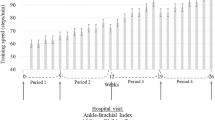Summary
Twenty-one patients with intermittent claudication underwent a physical exercise program lasting 8 weeks. The patients were classified on the basis of maximal walking tolerance (MWT) and diagnosis at the initial examination. Seven of the patients had a MWT less than 1,000m and no symptoms of chronic obstructive airways disease (COAD) or angina (group A), seven had a MWT less than 1,000 m plus angina and/or COAD (group B) and seven had an unlimited (>1,250m) MWT (group C). At the completion of the training program all three groups showed a significant improvement in walking distance to pain and stress test capacity. During the post-training walking tolerance test, the venous lactate concentrations in group A were lower after 2 min and 4 min of exercise, and at exhaustion (P<0.05). Group A patients showed a significant correlation between an increase in MWT after training and a decrease in maximum lactate concentration measured during walking. Although the patients in group B had a significant increase in MWT, blood lactate concentrations in this group were not always decreased by physical training. Group C lactate concentrations were lower after 8 min, 15 min, and 30 min of walking (P<0.05). It is concluded that a physical training program increases walking tolerance in different categories of claudicants, and possible mechanisms for the improvement are discussed.
Similar content being viewed by others
References
Alpert JS, Larsen OA, Lassen NA (1969) Exercise and intermittent claudication. Blood flow in the calf muscle during walking studied by the Xenon-133 clearance method. Circulation 39: 353–359
Belman MJ, Kendregan BA (1981) Exercise training fails to increase skeletal muscle enzymes in patients with chronic obstructive pulmonary disease. Am Rev Respir Dis 123: 256–261
Chung EK (1979) Protocols for the exercise ECG test. In: Exercise electrocardiography: Practical approach Chung EK (ed) The Williams and Wilkins Co, Baltimore, p 119
Dahllöf A-G, Björntorp P, Holm J, Schersten T (1974) Metabolic activity of skeletal muscle in patients with peripheral arterial insufficiency. Effect of physical training. Eur J Clin Invest 4: 9–15
Dahllöf A-G, Holm J, Schersten T, Sivertsson R, Carlsöö S (1975) Effect of controlled training with respect to walking tolerance, maximal calf muscle blood flow, gait technique and muscle metabolism in patients with peripheral arterial insufficiency. Akt Probl Angiol 30: 114–120
Dahllöf A-G, Holm J, Schersten T, Sivertsson R (1976) Peripheral arterial insufficiency. Effect of physical training on walking tolerance, calf blood flow, and blood flow resistance. Scand J Rehab Med 8: 19–26
Ekroth R, Dahllöf A-G, Gundevall B, Holm J, Schersten T (1978) Physical training of patients with intermittent claudication: Indications, methods, and results. Surgery 84: 640–643
Hughson WG, Mann JI, Garrod A (1978) Intermittent claudication: prevalence and risk factors. Br Med J 1: 1379–1381
Jonason T, Jonzon B, Ringqvist I, öman-Rydberg A (1979) Effect of physical training on different categories of patients with intermittent claudication. Acta Med Scand 206: 253–258
Köhler M (1971) Lactat- und Pyruvatverhalten im femoralvenosen Blut vor und nach gezieltem Training bei Okklusion der Arteria femoralis. Klin Wochenschr 49: 1210–1218
Larsen OA, Lassen NA (1966) Effect of daily muscular exercise in patients with intermittent claudication. Lancet 2: 1093–1096
Schoop W (1973) Mechanism of beneficial action of daily walking training of patients with intermittent claudication. Scand J Clin Lab Invest [Suppl 128] 31: 197–199
Skinner JS, Strandness DE (1967) Exercise and intermittent claudication II: Effect of physical training. Circulation 36: 23–29
Sorlie D, Myhre K (1978) Effects of physical training in intermittent claudication. Scand J Clin Lab Invest 38: 217–222
Sorlie D, Straume B, Grimsgaard C, Johnsrud NK (1978) Arterial collateral vessels in legs with obliterative arteriosclerosis. Scand J Clin Lab Invest 38: 361–367
Zetterquist S (1970) The effect of active training on the nutritive blood flow in exercising ischemic legs. Scand J Clin Lab Invest 25: 101–111
Author information
Authors and Affiliations
Rights and permissions
About this article
Cite this article
Ruell, P.A., Imperial, E.S., Bonar, F.J. et al. Intermittent claudication. Europ. J. Appl. Physiol. 52, 420–425 (1984). https://doi.org/10.1007/BF00943373
Accepted:
Issue Date:
DOI: https://doi.org/10.1007/BF00943373




